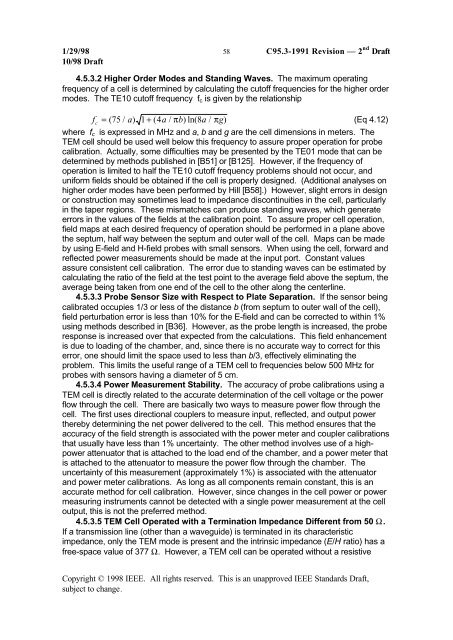DRAFT Recommended Practice for Measurements and ...
DRAFT Recommended Practice for Measurements and ...
DRAFT Recommended Practice for Measurements and ...
You also want an ePaper? Increase the reach of your titles
YUMPU automatically turns print PDFs into web optimized ePapers that Google loves.
1/29/98 58 C95.3-1991 Revision — 2 nd Draft<br />
10/98 Draft<br />
4.5.3.2 Higher Order Modes <strong>and</strong> St<strong>and</strong>ing Waves. The maximum operating<br />
frequency of a cell is determined by calculating the cutoff frequencies <strong>for</strong> the higher order<br />
modes. The TE10 cutoff frequency f c is given by the relationship<br />
f = ( 75 / c<br />
a ) 1 + ( 4 a / πb ) ln( 8 a / π g )<br />
(Eq 4.12)<br />
where f c is expressed in MHz <strong>and</strong> a, b <strong>and</strong> g are the cell dimensions in meters. The<br />
TEM cell should be used well below this frequency to assure proper operation <strong>for</strong> probe<br />
calibration. Actually, some difficulties may be presented by the TE01 mode that can be<br />
determined by methods published in [B51] or [B125]. However, if the frequency of<br />
operation is limited to half the TE10 cutoff frequency problems should not occur, <strong>and</strong><br />
uni<strong>for</strong>m fields should be obtained if the cell is properly designed. (Additional analyses on<br />
higher order modes have been per<strong>for</strong>med by Hill [B58].) However, slight errors in design<br />
or construction may sometimes lead to impedance discontinuities in the cell, particularly<br />
in the taper regions. These mismatches can produce st<strong>and</strong>ing waves, which generate<br />
errors in the values of the fields at the calibration point. To assure proper cell operation,<br />
field maps at each desired frequency of operation should be per<strong>for</strong>med in a plane above<br />
the septum, half way between the septum <strong>and</strong> outer wall of the cell. Maps can be made<br />
by using E-field <strong>and</strong> H-field probes with small sensors. When using the cell, <strong>for</strong>ward <strong>and</strong><br />
reflected power measurements should be made at the input port. Constant values<br />
assure consistent cell calibration. The error due to st<strong>and</strong>ing waves can be estimated by<br />
calculating the ratio of the field at the test point to the average field above the septum, the<br />
average being taken from one end of the cell to the other along the centerline.<br />
4.5.3.3 Probe Sensor Size with Respect to Plate Separation. If the sensor being<br />
calibrated occupies 1/3 or less of the distance b (from septum to outer wall of the cell),<br />
field perturbation error is less than 10% <strong>for</strong> the E-field <strong>and</strong> can be corrected to within 1%<br />
using methods described in [B36]. However, as the probe length is increased, the probe<br />
response is increased over that expected from the calculations. This field enhancement<br />
is due to loading of the chamber, <strong>and</strong>, since there is no accurate way to correct <strong>for</strong> this<br />
error, one should limit the space used to less than b/3, effectively eliminating the<br />
problem. This limits the useful range of a TEM cell to frequencies below 500 MHz <strong>for</strong><br />
probes with sensors having a diameter of 5 cm.<br />
4.5.3.4 Power Measurement Stability. The accuracy of probe calibrations using a<br />
TEM cell is directly related to the accurate determination of the cell voltage or the power<br />
flow through the cell. There are basically two ways to measure power flow through the<br />
cell. The first uses directional couplers to measure input, reflected, <strong>and</strong> output power<br />
thereby determining the net power delivered to the cell. This method ensures that the<br />
accuracy of the field strength is associated with the power meter <strong>and</strong> coupler calibrations<br />
that usually have less than 1% uncertainty. The other method involves use of a highpower<br />
attenuator that is attached to the load end of the chamber, <strong>and</strong> a power meter that<br />
is attached to the attenuator to measure the power flow through the chamber. The<br />
uncertainty of this measurement (approximately 1%) is associated with the attenuator<br />
<strong>and</strong> power meter calibrations. As long as all components remain constant, this is an<br />
accurate method <strong>for</strong> cell calibration. However, since changes in the cell power or power<br />
measuring instruments cannot be detected with a single power measurement at the cell<br />
output, this is not the preferred method.<br />
4.5.3.5 TEM Cell Operated with a Termination Impedance Different from 50 W.<br />
If a transmission line (other than a waveguide) is terminated in its characteristic<br />
impedance, only the TEM mode is present <strong>and</strong> the intrinsic impedance (E/H ratio) has a<br />
free-space value of 377 Ω. However, a TEM cell can be operated without a resistive<br />
Copyright © 1998 IEEE. All rights reserved. This is an unapproved IEEE St<strong>and</strong>ards Draft,<br />
subject to change.
















